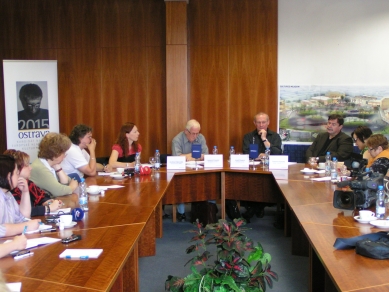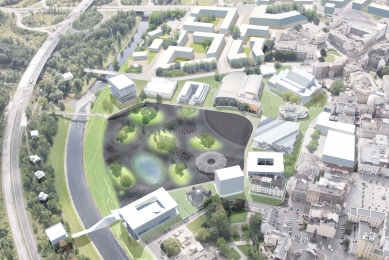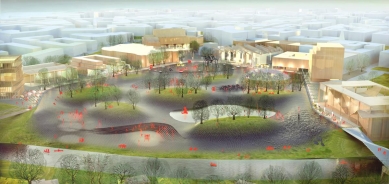
In the urban design competition for the revitalization of the Černá louka area, the Dutch studio Maxwan won
Source
Ostrava 2015
Ostrava 2015
Publisher
Tisková zpráva
18.06.2010 17:50
Tisková zpráva
18.06.2010 17:50
Rients Dijkstra
Maxwan architects + urbanists
The results of the international combined urban design competition for the revitalization proposal of the Černá louka area in Ostrava were announced today at a press conference in the congress hall of Pavilion A at the Černá louka Exhibition Grounds. A total of 70 architectural offices registered for the competition, which was announced by the statutory city of Ostrava on February 1 and had a deadline of May 31. Among the foreign participants were Foreign Office Architects (United Kingdom), Maxwan (Netherlands), NL architects (Netherlands), and Lacaton & Vassal Architectes (France). An eleven-member jury composed of renowned urban planners, architects, and representatives of the city of Ostrava, led by architect Josef Pleskot, decided by a significant majority on the winner, which was the proposal by the Dutch office Maxwan.
As stated by the chairman of the jury, architect Josef Pleskot, the winning proposal is remarkable for its architectural-urban treatment of space that emphasizes the whole rather than individual buildings. "This proposal captured the absolute majority of the jury because it exudes an undeniable charm. It presents a really interesting concept of a specific, original urban space that Černá louka truly is, which may not seem apparent at first sight. This design managed to extract the essence from that forgotten place, which lies between the city and nature. It succeeded in connecting nature to the city and the city to nature," Pleskot evaluated the merits of the winning project.
The individual buildings planned for Černá louka include a concert hall, an exhibition hall (Kunsthalle), a center for modern music (Music Pavilion), a complex of schools from kindergarten, primary and secondary schools to a creative incubator combined with a school for arts management, and residential buildings. These buildings in Maxwan's proposal are arranged in a kind of semicircle, reminiscent of a western town or a colonnade. The remaining space is reserved for a park of the 21st century, as Josef Pleskot called it. "It is neither the type of an English park, which is a free nature area, nor is it the geometrized form of a French park, but both of these types are contained in it to some extent. There are various elements for play, for meetings, there is a certain barrier-free accessibility or flow in all directions," said Pleskot.
The Dutch urban planning office was established in 1994. Its first commission and realization was the master plan for the newly emerging Dutch city of Leidsche Rijn (on the outskirts of Utrecht). Today, 75,000 people live there. In 2004, the head of Maxwan, Rients Dijkstra, was appointed as one of the advisors to the mayor of London for new urban development. In 2003, they began designing a new urban district Barking Reach (10,800 residential units) on the eastern edge of London. Construction is currently ongoing. Maxwan has won many urban design competitions (Moscow, Kaunas, Kyiv, Antwerp).
The social-cultural cluster Černá louka is a key project for Ostrava in the fight for the prestigious title of European Capital of Culture 2015.
In the past, the area of Černá louka was an intensively used open landscape lying between the historical city and the Ostravice River. It was the area through which the significant old Vítkovice road passed from the south, leading to one of the three city gates - the Vítkovice gate. It was always an area subject to many influences, in which a large number of suburban, civilizational, and natural phenomena occurred. Cattle trading took place here, and it was also a safe floodplain for the Ostravice River.
With the advancing industrialization of Ostrava, impenetrable barriers began to emerge there. Černá louka became a depot area, a dump, a storage area, in short, an industrial zone that separated the city from its river and landscape for a long time.
In recent decades, the barriers of Černá louka have been gradually, quite naturally, eliminated. For a time, part of its area became a fenced site for exhibitions, shows, and many other occasional activities.
Although Černá louka began to reshape itself as a unique urban space within the rehabilitating image of the center, numerous barriers still remained.
The unique significance of Černá louka within the entire city has been recognized by the actors of the project Ostrava - European Capital of Culture 2015. They defined it as a potential cultural cluster and initiated an ideational urban competition, whose main tasks were to confirm its perceived uniqueness, find a way to perfectly open it to the entire city and its residents, and create a place with a specific atmosphere where it would be possible to demonstrate to Europe the spirit of an original city and the entire region of which it is a part.
The competition proposals that managed to achieve the established values most convincingly progressed to the final evaluation round. These were proposals that showed that all expectations could be met. They undoubtedly demonstrated that the space of Černá louka can be perfectly transformed so that it becomes a place of concentrated, intense social energy for Ostrava, where the most significant urban buildings such as concert halls, exhibition halls, and others can be safely placed.
Moreover, the winning proposal proved that it is possible to create a completely original friendly urban landscape on Černá louka, or a kind of contemporary park that will become a magnet with the power to unite the entire city.
The competition jury recommends that the city politicians recognize the quality of the winning proposal and allow its authors to influence the creation of a territorial urban study that must be subsequently developed by the city. It further recommends supporting, strengthening, and developing the proposal during its implementation, thus creating for the citizens of the city "a place for a happy life".
The results of the competition have unequivocally proven the correctness of the decisions made by city representatives to organize it under unusually high standards.
As stated by the chairman of the jury, architect Josef Pleskot, the winning proposal is remarkable for its architectural-urban treatment of space that emphasizes the whole rather than individual buildings. "This proposal captured the absolute majority of the jury because it exudes an undeniable charm. It presents a really interesting concept of a specific, original urban space that Černá louka truly is, which may not seem apparent at first sight. This design managed to extract the essence from that forgotten place, which lies between the city and nature. It succeeded in connecting nature to the city and the city to nature," Pleskot evaluated the merits of the winning project.
The individual buildings planned for Černá louka include a concert hall, an exhibition hall (Kunsthalle), a center for modern music (Music Pavilion), a complex of schools from kindergarten, primary and secondary schools to a creative incubator combined with a school for arts management, and residential buildings. These buildings in Maxwan's proposal are arranged in a kind of semicircle, reminiscent of a western town or a colonnade. The remaining space is reserved for a park of the 21st century, as Josef Pleskot called it. "It is neither the type of an English park, which is a free nature area, nor is it the geometrized form of a French park, but both of these types are contained in it to some extent. There are various elements for play, for meetings, there is a certain barrier-free accessibility or flow in all directions," said Pleskot.
The Dutch urban planning office was established in 1994. Its first commission and realization was the master plan for the newly emerging Dutch city of Leidsche Rijn (on the outskirts of Utrecht). Today, 75,000 people live there. In 2004, the head of Maxwan, Rients Dijkstra, was appointed as one of the advisors to the mayor of London for new urban development. In 2003, they began designing a new urban district Barking Reach (10,800 residential units) on the eastern edge of London. Construction is currently ongoing. Maxwan has won many urban design competitions (Moscow, Kaunas, Kyiv, Antwerp).
The social-cultural cluster Černá louka is a key project for Ostrava in the fight for the prestigious title of European Capital of Culture 2015.
Memo from the Jury
The Černá louka area confirmed through the competition evaluation that it is not merely a backup area for the expansion of the historic center of Ostrava, but a space where it pays off to add higher urban and architectural values, as it can quickly become a social and cultural center for the entire city of Ostrava.In the past, the area of Černá louka was an intensively used open landscape lying between the historical city and the Ostravice River. It was the area through which the significant old Vítkovice road passed from the south, leading to one of the three city gates - the Vítkovice gate. It was always an area subject to many influences, in which a large number of suburban, civilizational, and natural phenomena occurred. Cattle trading took place here, and it was also a safe floodplain for the Ostravice River.
With the advancing industrialization of Ostrava, impenetrable barriers began to emerge there. Černá louka became a depot area, a dump, a storage area, in short, an industrial zone that separated the city from its river and landscape for a long time.
In recent decades, the barriers of Černá louka have been gradually, quite naturally, eliminated. For a time, part of its area became a fenced site for exhibitions, shows, and many other occasional activities.
Although Černá louka began to reshape itself as a unique urban space within the rehabilitating image of the center, numerous barriers still remained.
The unique significance of Černá louka within the entire city has been recognized by the actors of the project Ostrava - European Capital of Culture 2015. They defined it as a potential cultural cluster and initiated an ideational urban competition, whose main tasks were to confirm its perceived uniqueness, find a way to perfectly open it to the entire city and its residents, and create a place with a specific atmosphere where it would be possible to demonstrate to Europe the spirit of an original city and the entire region of which it is a part.
The competition proposals that managed to achieve the established values most convincingly progressed to the final evaluation round. These were proposals that showed that all expectations could be met. They undoubtedly demonstrated that the space of Černá louka can be perfectly transformed so that it becomes a place of concentrated, intense social energy for Ostrava, where the most significant urban buildings such as concert halls, exhibition halls, and others can be safely placed.
Moreover, the winning proposal proved that it is possible to create a completely original friendly urban landscape on Černá louka, or a kind of contemporary park that will become a magnet with the power to unite the entire city.
The competition jury recommends that the city politicians recognize the quality of the winning proposal and allow its authors to influence the creation of a territorial urban study that must be subsequently developed by the city. It further recommends supporting, strengthening, and developing the proposal during its implementation, thus creating for the citizens of the city "a place for a happy life".
The results of the competition have unequivocally proven the correctness of the decisions made by city representatives to organize it under unusually high standards.
The English translation is powered by AI tool. Switch to Czech to view the original text source.



29 comments
add comment
Subject
Author
Date
černa kostka černa louka černa duše
Václav Kocián
18.06.10 06:11
Toto má být "městský" kulturní klastr?
Jan Vrbka
19.06.10 12:13
K čemu se píší soutěžní podmínky
účastník
19.06.10 02:58
soda
jan gadziala
19.06.10 02:32
zvláštní...
Mario
19.06.10 11:14
show all comments
Related articles
0
12.04.2018 | Ostrava University acquired land for the construction of new facilities
0
28.09.2016 | Ostrava University plans to build a new Faculty of Arts
0
07.06.2012 | Ostrava has completed the territorial study of the Černá louka exhibition grounds
0
04.02.2012 | Ostrava continues to work on transforming the exhibition grounds, with a reduction in cultural buildings
0
15.09.2010 | The architects will prepare a land study for Ostrava's Černé Louky
0
01.07.2010 | The future of Ostrava's Černá louka will be decided in September
4
27.06.2010 | First place in the urban planning competition for the revitalization of the Černá louka area
0
27.06.2010 | Second place in the urban planning competition for the revitalization of the Černá louka area
0
17.02.2010 | Recognized architects will receive 540,000 from Ostrava
0
01.02.2010 | Ostrava invites architects, announced an international competition
9
26.01.2010 | An international urban planning competition is being prepared in Ostrava












